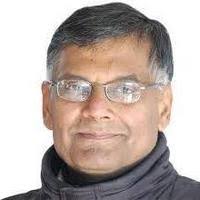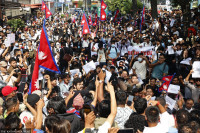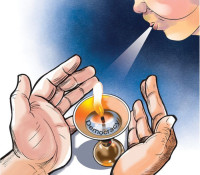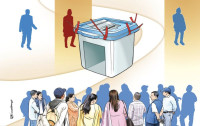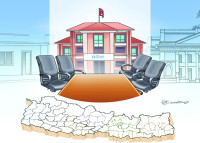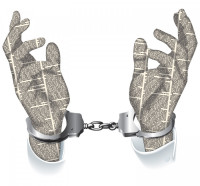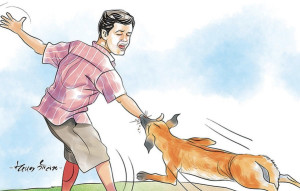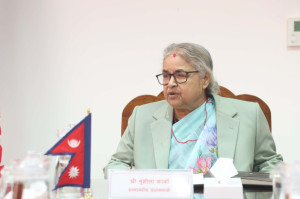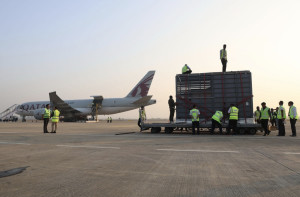Columns
Why Nepal's existing constitution is innately flawed
Nepal has had seven constitutions in as many decades; the latest one is entering middle age..jpg&w=900&height=601)
CK Lal
The contested constitution in Nepal is the seventh one in as many decades. By that reckoning, the average age of statutes in Nepal is 10 years. It implies that the present charter will be entering middle age this week. The government wants to mark the occasion with festivities to ensure its longevity. Every Poush 1 during the Panchayat era, civil servants were asked to compulsorily present themselves in official celebrations duly attired in the labeda-suruwal ensemble complete with Western jackets of the right colour and black leather shoes. The ones in Kathmandu gathered at what was then called the Royal Army Pavilion.
In a decision reminiscent of diktats of the despicable royal-military regime, the incumbent Oli-garchy has decreed that all government employees must present themselves duly dressed in the appropriate manner. The prescribed attire for everyone else is a designer T-shirt with the national flag emblazoned on the chest. The government wants you to prove your fealty to the new set of rulers. Rightly has it been said that the more things change, the more they stay the same.
In order to drive home the point, spokesperson for the Nepal Communist Party government and Minister of Information and Communications Gokul Prasad Baskota pronounced that the Constitution Day holiday wasn’t meant to be wasted on drinking, dating and making merry. The instruction is intended to make everyone become a nationalist in every sense including the darker connotations of the term.
Minister Baskota keeps putting his foot in his mouth quite often with odious outbursts, but the edict to swear loyalty to the contested charter carries deeper meaning. It implies, among other things, that the party with a two-thirds majority in Parliament isn’t too sure of its ability to politically defend the controversial constitution. The regime also seems to suspect that the opposition parties will not be too willing to come to the government's rescue if the plank upon which it stands—the controversial constitution—were to be pulled away under any pretext.
Performance anxiety
The sins of the past seem to be catching up with ruling party supremo and Prime Minister Khadga Prasad Sharma Oli as well as his alter ego Pushpa Kamal Dahal. Premier Sharma Oli is the Maoist of the 1970s while the letter-head chairman Dahal dipped his fingers in the blood-soaked ideology sometime in the 1990s. Those that cause dread are accursed to live in fear forever. Scared of their own shadows, law enforcement agencies took some senior citizens, including former deputy inspector general Bijaya Raj Bhatta and former Nepal Army major Keshav Basnet, into custody on the day of Indra Jatra. They also confiscated some black T-shirts.
By all accounts, Gyanendra Shahi is a small-time agitator with neither the ability nor the organisational resource to challenge what has been touted as the most powerful government in Nepal’s recent history. Television personality Rabi Lamichhane is being investigated for his possible involvement in a criminal case. However, it’s ridiculous to present Shahi and Lamichhane or their raucous supporters as threats to the republican order of democracy, secularism, inclusion and federalism. The current spate of fear-mongering is perhaps born out of guilt. The Khas-Arya solidarity that manifested itself in the 16-Point Conspiracy has been unsuccessful in widening the acceptability base of the contested charter.
Political groups that failed to get the promised amendments have resolved to abstain from Constitution Day revelries. Samajbadi Party Nepal, a coalition partner of the government, has decided to stay away from formal functions. Rastriya Janata Party Nepal is unlikely to give up its position on the contested charter and endorse official celebrations. Several Janajati groups have expressed their reservations, and Dalits have nothing to celebrate. It seems the country's seventh constitution obtained the acquiescence of voters, but failed to acquire the legitimacy of acceptance.
A cursory overview of possible reasons behind the failure of six previous constitutions can perhaps reveal the reason behind the flailing nature of the existing statute. The first one—the Government of Nepal Act 1948—lacked elite consensus of the Rana and unravelled due to internal rivalries. Gradual decay of the Interim Government Act of Nepal 1951 began the moment king Tribhuvan reneged on his promise to institutionalise a republic through Constituent Assembly elections. King Mahendra promulgated the Constitution of the Kingdom of Nepal 1959 under duress, and he wasn’t committed to the concept of constitutional monarchy from day one. It was fated at birth to fail.
The Constitution of Nepal 1962 was, in fact, a royal proclamation meant to legitimise the monarch's autocratic rule. The Constitution of the Kingdom of Nepal 1990 was a document of tripartite compromise. The statute died a slow, painful and unsung death as a result of the creeping coup that began with the dissolution of Parliament in May 2002 and the subsequent declaration of internal emergency.
The Interim Constitution of Nepal 2007, with amendments made after the first and second Madhes Uprisings, was the most progressive statute in the history of the country. It sought to institutionalise a federal, democratic, inclusive and secular republic through an elected Constituent Assembly. The so-called politics of consensus killed its spirit. The idea of democracy without an opposition is inconceivable. Lack of a functional opposition turns all dissenters into enemies of the system. That’s the innate flaw of the existing statute, the Constitution of Nepal 2015. The fundamental premise of the charter was the division of spoils of office. An ambitious dotard, the then de jure prime minister Sushil Koirala wanted to retire as head of state.
Even though Sharma Oli was the de facto head of government at that time, he desired to be the supremo of a communist order as the last and just reward of having spent 14 years in jail in the prime of his life. Defeated and lost, Dahal just wanted to protect his human and material assets accumulated during the 12 years of the armed conflict. A quintessential opportunist, Bijay Kumar Gachhadar had no purpose but to bask in the reflected glory of the main players. Except for Koirala, every signatory to the 16-point conspiracy has achieved what they had wanted. Koirala is gone, and the rest no longer have any stake in defending the statute. The political lassitude of the masses is its only protection. On that note, do drink, date and make merry, whoever wants to do so over the extended weekend!
***
What do you think?
Dear reader, we’d like to hear from you. We regularly publish letters to the editor on contemporary issues or direct responses to something the Post has recently published. Please send your letters to [email protected] with "Letter to the Editor" in the subject line. Please include your name, location, and a contact address so one of our editors can reach out to you.




 7.37°C Kathmandu
7.37°C Kathmandu